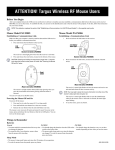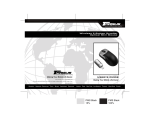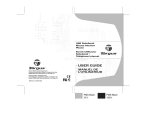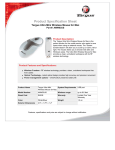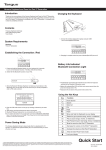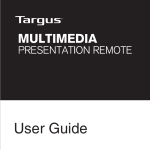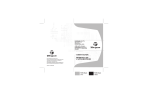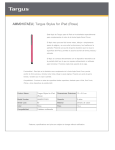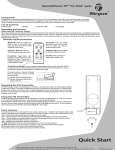Download Targus Wireless RF Mouse User's Manual
Transcript
Targus Wireless RF Mouse Making Your Mobile Life Easier. USER’S GUIDE Visit our Web site at: www.targus.com Making Your Mobile Life Easier. Features and specifications are subject to change without notice. © 2002 Targus Corp. 400-0078-001A 2 Targus Wireless RF Mouse Introduction Congratulations on your purchase of a Targus Wireless RF Mouse. This ergonomically designed mouse uses a radio frequency (RF) link that enables you to use the mouse anywhere within 3 feet of its receiver. No line-of-sight between the mouse and its receiver is required. This user’s guide describes how to connect the mouse receiver to your computer, install default software drivers and set up the radio link for the following RF mouse models: • PAUM005 – Mini 3-button RF Optical Mouse with scrolling wheel • PAUM006 – Mini 3-button RF Mouse with scrolling wheel In addition to this user’s guide, depending on the RF mouse model that you purchased, this package contains: PAUM005 PAUM006 • Mouse • Receiver • 2 AA batteries • Three inch USB extension cable • Optional charger base available (part number 252-0013-001A) • Mouse • Receiver • 2 AAA batteries 3 Targus Wireless RF Mouse System Requirements To use the RF mouse, your computer must meet the following hardware requirements and run one of the operating systems listed below. Hardware Operating System • PC with a Pentium® processor or equivalent and a hard disk drive • Windows® 98/Me/ 2000/XP • USB version 1.1 interface NOTE: The third button and the scrolling wheel only work with the operating systems listed above. If you use the RF mouse with a different operating system, it will lose its enhanced features and function as a standard, two-button mouse. Connecting the Mouse Receiver and Installing the Device Drivers To connect the mouse receiver: 1 Turn off your computer. 2 Plug the standard USB end of the cable into an available USB port on your computer. You are now ready to install the device drivers for your operating system. Targus Wireless RF Mouse 4 Windows® 98/Me Operating Systems 1 Turn on your computer. The Add New Hardware Wizard appears. If it does not, the operating system has installed the default driver automatically. No other steps are necessary. 2 Click Next. The locate driver screen appears. 3 Select “Search for the best driver for your device. (Recommended),” and then click Next. The wizard searches for the appropriate device driver. 4 Click Next. 5 Click Finish to complete the driver installation. You are now ready to install the batteries in the mouse, set the radio frequency channel, and establish a communications link between the mouse and its receiver. See “Establishing a Communications Link (All RF Mouse Models)” on page 6. Targus Wireless RF Mouse 5 Windows® 2000/XP Operating Systems 1 Turn on your computer. The Found New Hardware Wizard appears. If it does not, the operating system has installed the default driver automatically. No other steps are necessary. 2 Click Next. The wizard searches for the appropriate device driver. 3 Click Next. 4 Click Finish to complete the driver installation You are now ready to install the batteries in the mouse, set the radio frequency channel, and establish a communications link between the mouse and its receiver. See “Establishing a Communications Link (All RF Mouse Models)” on page 6. Using the RF Mouse Installing the Batteries 1 Remove the battery cover from the bottom of the mouse by pressing the battery cover tab and siding it off. NOTE: If you have a model PAUM005 RF mouse, the battery cover is also the top cover of the mouse. Targus Wireless RF Mouse 6 2 Insert the supplied batteries, making sure that the positive (+) and negative (-) ends of each battery match the polarity indicators inside the battery housing. 3 Slide the battery cover back into position until it “clicks” firmly into place. If you have a model PAUM005 RF mouse, the optical sensor, located on the bottom of the mouse, glows red. WARNINGS: When replacing the batteries, you may use alkaline or other heavy-duty NiMH batteries. Never use an alkaline with a NiMH battery in a device. Avoid mixing new and used batteries in a device. Establishing a Communications Link (All RF Mouse Models) The RF mouse has 256 identification codes that allow the mouse and its receiver to operate without interference from other radio frequency devices. To set the identification code and establish a radio link between the mouse and the receiver: 1 Press and release the link button, located on the bottom of the RF mouse. 2 Press and release the link button on the receiver. Targus Wireless RF Mouse 7 The receiver’s status light flashes while it scans the identification codes for the mouse. Once a code is selected, the status light stops flashing. 3 Press and release the screen scroller (middle) button. You are now ready to use the RF mouse. NOTE: You must reestablish the communications link every time you change the batteries. Operating Hints For optimal performance and RF reception: • Place the receiver at least 8 inches (20 cm) away from all electrical devices, such as your monitor, speakers or external storage devices. • Avoid using the RF mouse on a metal surface. Metals, such as iron, aluminum or copper, shield the radio frequency transmission and may slow down the mouse’s response time or cause the mouse to fail temporarily. • The RF mouse will enter a suspend mode at the same time your computer does. To wake the mouse, press and release the screen scroller (middle) button. • If your computer has a metal case that contains aluminum or magnesium, use the RF mouse to the side. The display panel may interfere with the radio frequency signal if you use the mouse directly in front of the computer. Targus Wireless RF Mouse 8 If you are using an optical RF mouse (model PAUM005): • Never use the RF mouse on a glass or mirrored surface as these surfaces will cause the mouse to fail temporarily. • To maximize battery life, use the RF mouse on a white, or light colored surface. Dark surfaces cause the mouse’s light emitter diode (LED) light to glow brighter, which causes the battery to discharge more rapidly. Comfortable Usage Research suggests that physical discomfort and injury to nerves, tendons, and muscles may be related to repetitive motion, an improperly set up work area, incorrect body posture, and poor work habits. To reduce the risk of injury, follow these precautions: • Stand, stretch, and move around several times every hour. • Switch hands while performing tasks. Use shortcut keys to avoid repetitive or awkward mouse movements. • Relax your shoulders and keep your elbows at your sides. Adjust the keyboard’s position so that you don’t have to stretch to reach it. Targus Wireless RF Mouse 9 • Adjust your position so that you don’t have to bend your wrists to type; avoid placing your wrists on a sharp edge. If you feel discomfort or numbness in your hands, wrists, arms, shoulders, neck, or back while typing, consult a qualified medical professional. Specifications NOTE: Specifications are for all models unless indicated otherwise. Models PAUM005 PAUM006 Button Count 3 with scrolling wheel ID Selections 256 Electromagnetic Characteristics (EMC) CE - Type acceptance: ETS 300 220 short range devices VCCI approval (Japan) - PAUM006 only Distance Between Mouse and Receiver PAUM005Up to 3 feet (1 m) PAUM006Up to 5 feet (1.6 m) Mouse Carrier Frequency 27 MHz Targus Wireless RF Mouse 10 Dimensions Mouse: PAUM005 3.86 x 2.32 x 1.5 inches (98 x 59 x 38 mm) PAUM006 3.82 x 2.24 x 1.25 inches (97 x 57 x 32 mm) Receiver: PAUM005 1.96 x 0.86 x 0.59 inches (50 x 22 x 15 mm) PAUM006 2.48 x 0.86 x 0.66 inches (63 x 22 x 17 mm) Weight Mouse (without batteries): PAUM005 3.74 ounces (106 grams) PAUM006 3.25 +/-.35 ounces (92 +/- 10 grams) Receiver: PAUM005 .56 ounces (16 grams) PAUM006 .98 ounces (28 grams) Receiver Interface USB version 1.1 Operating Voltage Mouse (powered by batteries): PAUM005 3.6V DC PAUM006 3V DC Receiver: 4.5 to 5.5V DC (powered by the USB port) Targus Wireless RF Mouse 11 Batteries PAUM005 2 AA Alkaline PAUM006 2 AAA Alkaline Operating Current Mouse:50~60mA (maximum) Receiver:30mA typically (100mA maximum) Mouse Standby Current 12mA or lower Mouse Sleep Mode Current Below 10uA Modulation Type FSK Transmission Rate 4K bps Error Detection 8-bit CRC Troubleshooting What do I do if the RF mouse does not work? • Make sure that the polarity of the batteries is correct. The positive (+) and negative (-) ends of each battery must match the positive (+) and negative (-) connections in the battery housing. • Check that the receiver’s USB connector is firmly attached to the USB port on your computer. Targus Wireless RF Mouse 12 • Verify that the device drivers are installed. • Make sure you have established a radio link between the mouse and its receiver. See “Establishing a Communications Link (All RF Mouse Models)” on page 6. When I use the RF mouse, other wireless devices work more slowly or fail temporarily – what should I do? The mouse may cause interference with any cordless, radio-based device that operates at 27 MHz, such as a telephone, baby monitor, or toy. To reduce interference, move the mouse’s receiver and the base unit of the affected device as far away from each other as possible. What do I do if the response time of the RF mouse is slow or the mouse intermittently stops working? • Increase the distance between the mouse’s receiver and the rest of your computer equipment. • Increase the distance between the mouse’s receiver and the base units of other wireless devices. • Turn off any wireless devices and their base units that are near the mouse’s receiver. • If you are using the RF mouse on a metal surface, move it and the receiver to a non-metal surface. Metals, such as iron, aluminum or copper, shield the radio frequency transmission and may slow down the mouse’s response time or cause the mouse to fail temporarily. 13 Targus Wireless RF Mouse I can’t use the RF mouse while another RF mouse is in use – what should I do? Reset the identification code. See “Establishing a Communications Link (All RF Mouse Models)” on page 6. Technical Support In the unlikely event that you encounter a problem with your Targus accessory, please contact our technical support team at: Email: [email protected] Internet: http://www.targus.com/support Our knowledgeable staff is also available to answer your questions through one of the following telephone numbers. North America Monday through Friday, 8:00 a.m. (08:00) to 8:00 p.m. (20:00) Eastern time: US & Canada 800-283-6325 Europe Belgium Denmark France Germany Italy +32 0 02-717-2451 +45 0 35-25-8751 +33 0 1-64-53-9151 +49 0 21-16-579-1151 +39 0 24-827-1151 14 Targus Wireless RF Mouse Netherlands Spain Sweden Switzerland United Kingdom Eastern Europe & others +31 0 53-484-9470 +34 0 91-745-6221 +46 0 8-751-4058 +41 0 1-212-0007 +44 0 20-7744-0330 +31 0 53-484-9479 Product Registration For more efficient customer service and to activate the product’s warranty, Targus recommends that you register your Targus accessory shortly after purchasing it. To register your Targus accessory, go to: http://www.targus.com/registration.asp You will need to provide your full name, email address, phone number, and company information (if applicable). Warranty Targus warrants this product to be free from defects in materials and workmanship for one year. If your Targus accessory is found to be defective within that time, we will promptly repair or replace it. This warranty does not cover accidental damage, wear and tear, or consequential or incidental loss. Under no conditions is Targus liable for loss of, or damage to a computer; nor loss of, or damage to, programs, records, or data; nor any consequential or incidental damages, even if Targus has been informed of their possibility. This warranty does not affect your statutory rights. Warranty Registration at: http://www.targus.com/registration.asp Targus Wireless RF Mouse 15 Regulatory Compliance This device complies with Part 15 of the FCC Rules. Operation is subject to the following two conditions: (1) This device may not cause harmful interference, and (2) This device must accept any interference received, including interference that may cause undesired operation. FCC Statement Tested to Comply This equipment has been tested and found to comply with the limits of a Class B digital device, pursuant to Part 15 of the FCC Rules. These limits are designed to provide reasonable protection against harmful interference in a residential installation. This equipment generates, uses, and can radiate radio frequency energy and if not installed and used in accordance with the instructions, may cause harmful interference to radio communications. However, there is no guarantee that interference will not occur in a particular installation. If this equipment does cause harmful interference to radio or television reception, which can be determined by turning the equipment off and on, the user is encouraged to try to correct the interference by one or more of the following measures: • Reorient or relocate the receiving antenna • Increase the separation between the equipment and receiver • Move the computer away from the receiver • Connect the equipment into an outlet on a circuit different from that to which the receiver is connected. Windows is a registered trademark of Microsoft Corporation. All other trademarks are the property of their respective owners. Targus Wireless RF Mouse Making Your Mobile Life Easier. USER’S GUIDE Visit our Web site at: www.targus.com Making Your Mobile Life Easier. Features and specifications are subject to change without notice. © 2002 Targus Corp. 400-0078-001A
















